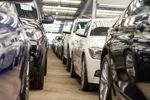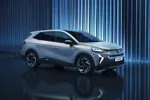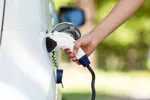Even without the current COVID-19 coronavirus crisis it was clear to everyone in the industry that automotive businesses are rapidly approaching a crossroads.
VW’s CEO, Herbert Deiss, has chosen his route. Not only has he stated openly that the business is pivoting to tech, he has also put his foot on the accelerator, wanting to take on Tesla in volumes of emission-free vehicles sold.
It’s a logical move, especially given the Society of Motor Manufacturers and Traders (SMMT) recently announced a 243% increase in electric vehicle (EV) sales in the UK.
As car sales slump further and the nations adjusts to the new COVID-19 reality, this doesn’t ease the bigger picture pressures with brands have to face.
Car sharing and subscriptions
Many brands are looking to choose between electric, personal mobility tech, or lease and car-sharing models.
Porsche have picked the latter, alongside Nissan, Mercedes-Benz and Audi, trialling their own subscription model.
These lower barriers to ownership encourage short-term trial without major financial outlay.
Lack of clarity on these issues leaves dealerships dangling – even as they close to customers at the moment.
Whether their parent brands decide to be tech, to be green, or to lease, it’s the dealer that bridges the gap with stymied customers, who have likely lost the immediate impetus to chance vehicles.
Dealers are still best-placed to advise people who find it hard to buy a diesel, or are still unconvinced by the range or the charging options available from an EV, or find it hard to justify the budgets for a petrol option.
The dealership plays an essential role: it's where people first get behind the wheel of their next car, no matter what technology fuels it.
The model has already faced several challenges resulting from the digital revolution, including the shift of consumer research towards online and connecting the virtual and physical experience gap.
The personal touch
It has always been the personal touch of a car brand, for both aftermarket and initial sales.
The current COVID-19 coronavirus shutdown sharpens these pressures, but they will remain the frontline for customers’ concerns about their changing transport needs.
Just because the brands’ propositions are changing doesn’t mean that the dealerships will be left behind.
When recognizing that Mazda had no physical dealer presence inside the M25, SYZYGY worked with the marque to offer a virtual dealership offering in London – where cars for trial would be driven to testers’ addresses to test drive.
This simple solution involved working closely with the brand to recognise where pain points existed in their digital and physical customer journeys.
This interplay between digital and dealer is still the biggest opportunity to encourage people into the physical location post-shutdown for first-hand advice – but brands should look to inform the initial online research phase too – and this is something which may still be ongoing while people remain in their homes.
Significant pain points exist for customers uncertain about what’s the best transport option for now and the future.
The demand for workable options will come back post-lockdown, but the path to the right choice is not obvious.
Taking the right path
Forward-thinking brands need to be solving these issues for customers if they want to smooth the path to purchase (or subscription).
This makes the path for short-term trial easier given lower commitments, but it may also be deferring the solution for people who may be ideal electric, hybrid or tech-led customers instead.
There are few trusted sources to help people decide which option may be best for them because the issue is so individualised.
Brands that know which fork in the road to take can start to pave the way for their customers with content to influence this all-important decision.
This is a tactic which worked well for AVIS, who were seeking to move car rental consideration further up the holiday booking agenda. We worked with them to develop a content platform, AVIS Inspires, focused around European city breaks and the unique destinations which are primarily accessible by car.
This approach ensured that holidaymakers looking at their travel options considered a car as integral to their planning, rather than an add-on purchase.
A similar content approach for dealerships or their parent brands could prove valuable in communicating with valued customers looking to make their next transport purchase – especially when they may be sitting at home, with more time than usual to spend their research phases.
Ultimately, what most in the industry need to remember is that although moving forward into the new world of electric, tech or rental while maintaining company clarity is key, petrol and diesel options are not going to disappear overnight – nor will their customers.
Looking beyond lockdown at the bigger automotive picture, the UK is currently on a timeline of 12 years before traditional fuels are phased out in favour of greener options, and people will keep needing to get around up until then.
By understanding the communications options at their disposal, the customer insights already at their fingertips, and the power of first-hand in-person advice, car brands already have all the tools they may need to advise their customers for the road immediately ahead, and what may be coming over the hill.
Author: Matt Wills, head of design and build at marketing agency Syzygy, London













Login to comment
Comments
No comments have been made yet.